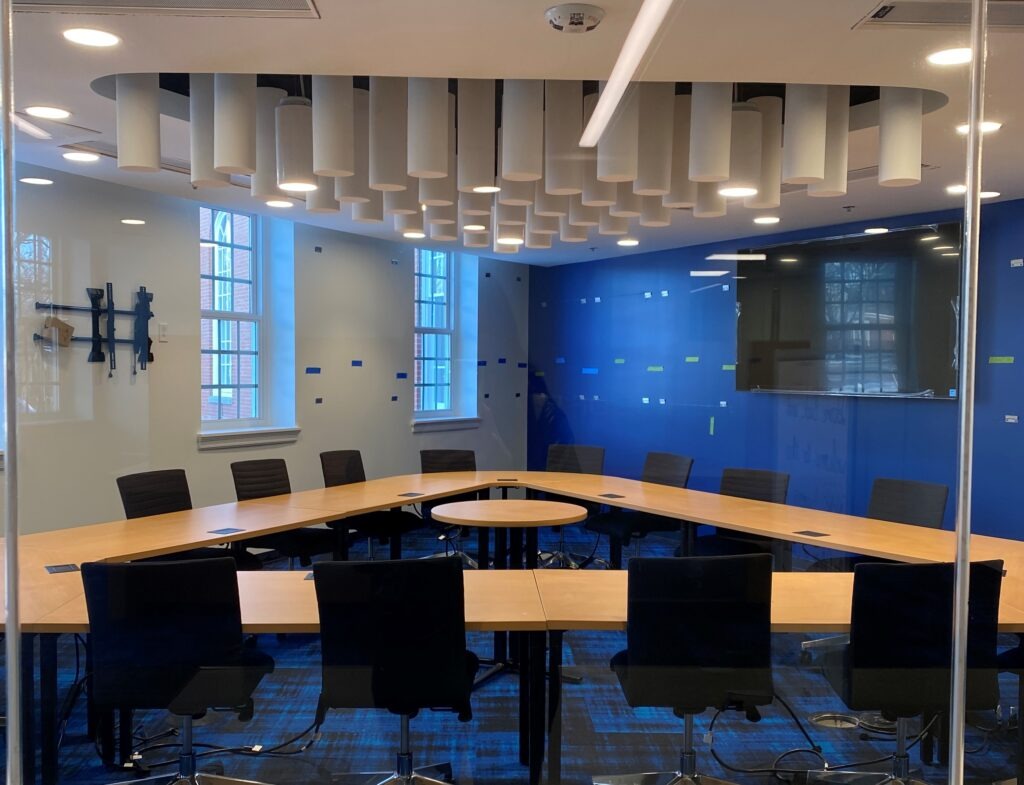Seacobeck Hall, new home of College of Education, finishes long awaited renovation
4 min read
Seacobeck Hall has newly renovated conference rooms that students can utilize. | Naomi Jones, The Weekly Ringer
by TABITHA ROBINSON
Staff Writer
While walking through Seacobeck Hall, the newly renovated home of the College of Education, Pete Kelly excitedly points out new conference rooms, original crown molding and tall windows letting in sunlight.
“We are really grateful in the College of Education to have good news,” said Kelly, the dean of the College of Education. “There’s this energy, this positivity. As hard as this job has been for everybody, and faculty are just so exhausted, this has been a really great shot in the arm.”
Seacobeck Hall was built in 1930 with two dining rooms and a central “dome room.” The building served as UMW’s dining hall until the University Center was built in 2015. It was named for a Native American village that occupied the area. According to Edward Alvey’s “History of Mary Washington College 1908-1972,” “Seacobeck is an Algonquin word that means ‘at the foot of the rock.’”
According to Kelly, there are ongoing discussions of putting a sign in Seacobeck explaining the history of the name.
“I like that the name relates to a certain culture and background, but I doubt many people know what it’s named after,” said Francesca Harrison, a sophomore elementary education major and Spanish minor. “Being an educator, it’s important to teach and learn about cultural diversity, so there is a strong correlation between the two.”
The renovation, which took about 4.5 years, retains many of the original decorative features, including crown molding, chandeliers, window trim and plaster ceiling reliefs. In terms of more modern elements, students hope the building has the technology needed to prepare tomorrow’s educators.
“I’m hoping this building is a more modern concept and has spaces for collaboration and has the technology to prepare us for our futures,” said Elizabeth Golden, a sophomore elementary education and biology major.
Seacobeck will include a maker lab with 3D printers, flexible event spaces, a curriculum lab and classrooms with multiple computers.
“I think the different kinds of classroom learning spaces that we’ve created are going to facilitate our ability to develop new ways of teaching,” said Kelly. “They’re going to be more interactive and have new technology.”
According to Kelly, three new classrooms in Seacobeck will be ready for students this semester, but students believe there is still work to be done.
“Some classrooms do not have smart boards, projectors or main computers for professors,” said Harrison. According to Kelly, technology installation is still ongoing.
Kelly is optimistic for the College of Education’s future.
“It’s positioning us well to help reinvent teaching and learning because that’s what we’re seeing right now in higher education and in K-12,” he said. “I don’t think we will go back to normal, and I don’t think that’s necessarily a bad thing. I think it’s kind of good to shake things up a bit. But with the technology, learning spaces and ability to collaborate, I think [Seacobeck] is going to help us with that transition and help us develop and share those new ways of teaching and learning with students before they go out in the world.”
Kelly says the nation’s current teacher shortage is affecting the College of Education, but he hopes Seacobeck will encourage prospective educators.
“We need to get people excited about teaching. If I get prospective students and parents in this building and they’re thinking about being a teacher, this building’s going to help me seal the deal,” he said. “It says teaching matters! The state invested $24 million in this building, and they did it to help address the teacher shortage. I think it’s going to help us.”
The main thing he is excited for, however, is the sense of community he hopes to create within the College of Education.
“I think the main thing that this building is going to help us do is really build community,” said Kelly. “We’ve been in James Farmer Hall, and it’s been a great building. We loved it. But essentially, we had a hallway with room for a couch and a small table. There was no place where students could engage with each other and work with each other and engage with faculty. So the goal is really developing a sense of a community within the College of Education, not just with students, but I also want to invite alumni.”
According to Kelly, Seacobeck Hall has always been a community project, starting with focus groups of students, alumni and faculty 4.5 years ago.
“It was really cool to build this dream together, and everybody had a hand in it, even when choosing furniture,” he said. “To see it come together is pretty magical.”
One way Kelly hopes to see community built is through student organizations.
“The Student Education Association’s (SEA) ability to engage and help create community within the student population is really going to be enhanced by having this space,” he said. “SEA does a conference and they’re planning on doing it in this building! We can shine a positive light on the campus and on the COE.”
Many College of Education students are excited to have their own space.
“I’m excited to have a space just for education,” said Golden. “Being in Farmer felt really cramped and there was no space to collaborate.”
Collaboration and community is the name of the game in Seacobeck as the College of Education seeks to move forward in a new learning environment.
“I’m most excited for the space itself,” said Harrison. “I’ve heard it has a ton of room and spaces to do work and hang out.”


